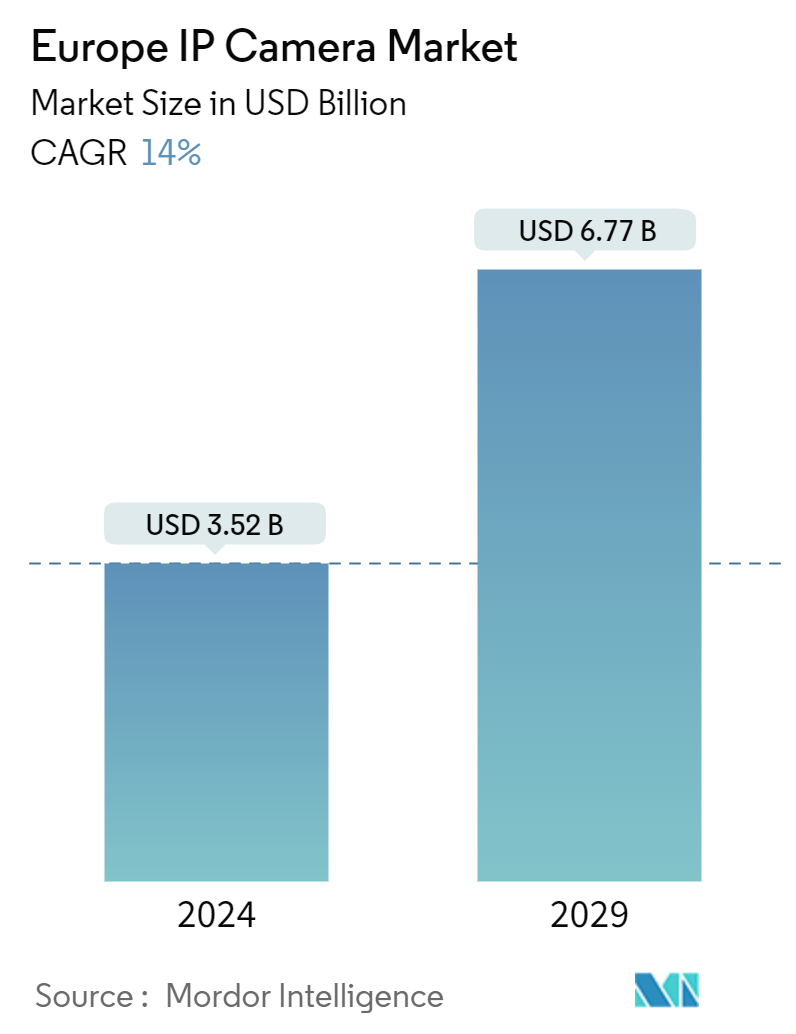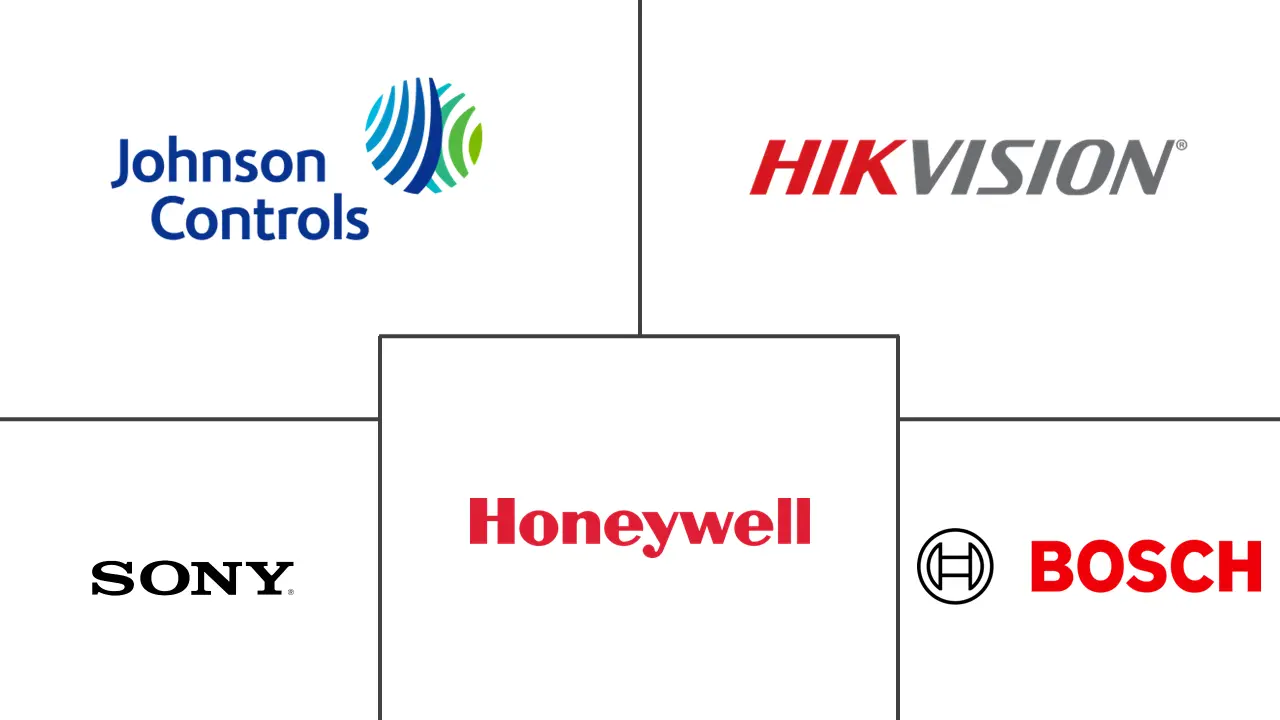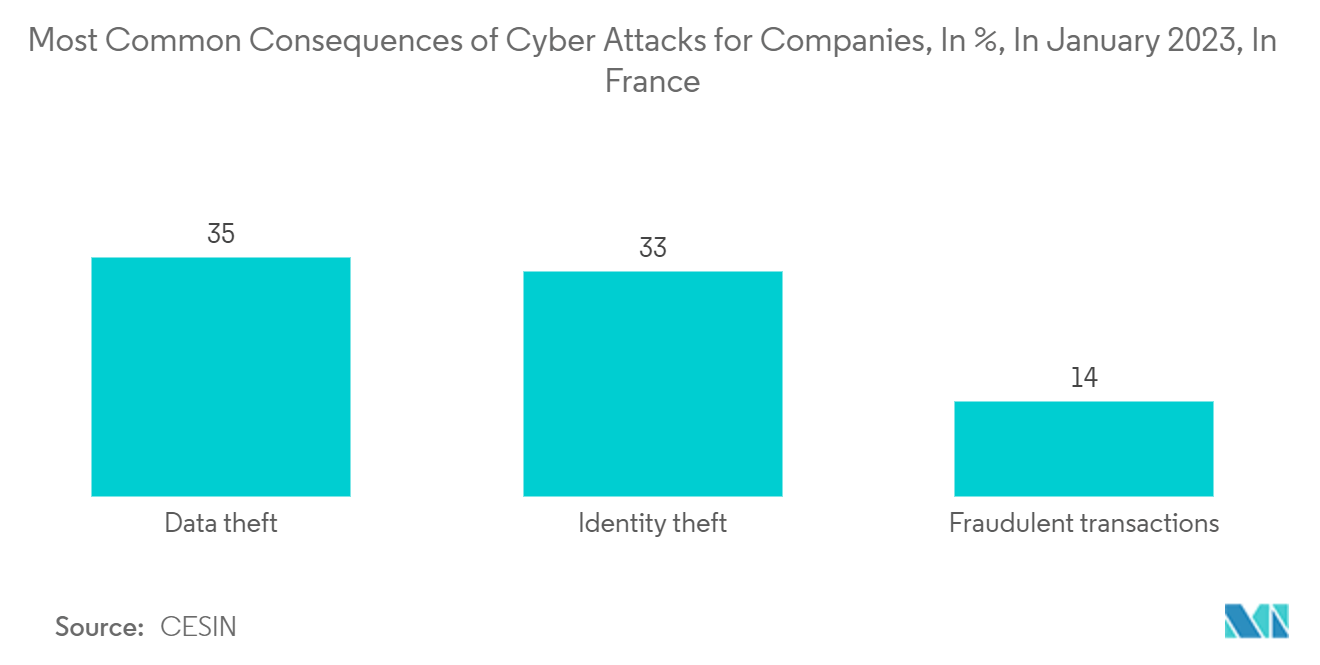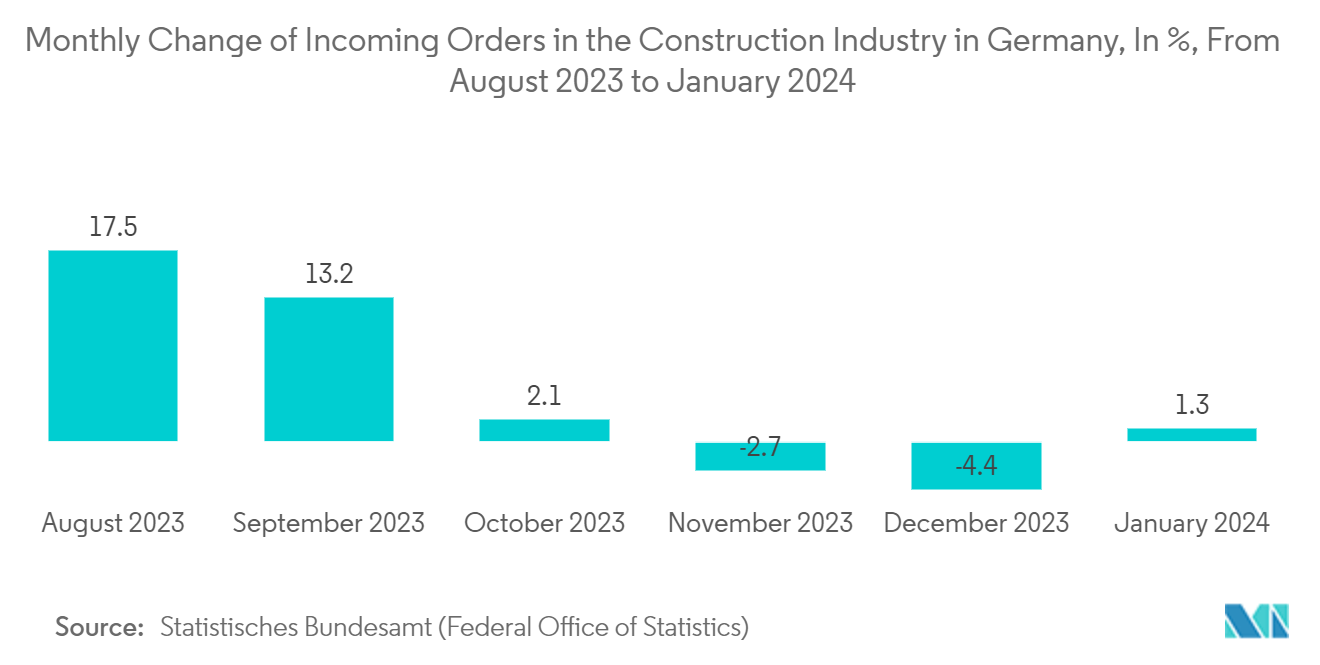Europe IP Camera Market Size

| Study Period | 2019 - 2029 |
| Base Year For Estimation | 2023 |
| Market Size (2024) | USD 3.52 Billion |
| Market Size (2029) | USD 6.77 Billion |
| CAGR (2024 - 2029) | 14.00 % |
| Market Concentration | Low |
Major Players
*Disclaimer: Major Players sorted in no particular order |
Europe IP Camera Market Analysis
The Europe IP Camera Market size is estimated at USD 3.52 billion in 2024, and is expected to reach USD 6.77 billion by 2029, growing at a CAGR of 14% during the forecast period (2024-2029).
• IP (Internet Protocol) is a digital security camera that transmits video through an IP network. These cameras are used for surveillance purposes. Unlike traditional CCTV cameras, IP cameras do not need a separate recording device; only a local network is required. IP cameras connect to a network in a similar manner as phones and computers do. With increasing concerns about safety and security at the individual and organizational levels, there's a growing need for surveillance systems, including IP cameras, to monitor and protect properties, assets, and people.
• Government regulations compliance and industry standards related to security and surveillance, especially in public places, transportation hubs, and critical infrastructure, drive the adoption of IP cameras for compliance and risk management. Moreover, the ongoing advancements in IP camera technology, such as higher resolutions, improved image quality, better low-light performance, advanced analytics capabilities, and integration with other security systems, make IP cameras more practical for various applications.
• Cameras are rising in the region due to growing industry security concerns. The industry's transition to IP cameras has brought hardware innovations that offer improved performance in low-light conditions, object tracking, and built-in security features. Technology advancements have led to the development of specialized surveillance cameras that can zoom in and scan items like dangerous equipment. These factors are predicted to drive the market's growth.
• Regulatory compliance with data protection regulations, privacy laws, and industry standards can pose challenges for IP camera deployments, especially in sectors such as finance, healthcare, and government, where strict rules govern the handling of sensitive information. Ensuring compliance with regulatory requirements adds complexity and cost to IP cameras. Furthermore, while IP cameras offer enhanced security features compared to analog cameras, the cameras are also vulnerable to cyber threats such as hacking, unauthorized access, and data breaches. Concerns about cybersecurity and privacy may deter some users from adopting IP cameras.
• Macroeconomic factors, such as heightened security concerns, including crime, terrorism, and public safety threats, increase the demand for surveillance solutions in the region. IP cameras are crucial in deterring and detecting security incidents and providing evidence for law enforcement investigations. Moreover, government policies related to surveillance and data protection impact the adoption of IP cameras in Europe. Compliance regulations such as the GDPR (General Data Protection Regulation) require careful consideration of data privacy and security requirements, influencing IP camera design deployment and use.
Europe IP Camera Market Trends
Commercial Sector to Witness a Significant Growth
• The commercial sector is experiencing notable growth as there is an increasing need for more innovative security technologies in the banking industry. The increase in retail theft is prompting the adoption of modern video solutions that can alert security personnel of unauthorized entry to the premises. Several companies are focusing on offering these enhanced security solutions, particularly for commercial purposes. For instance, in November 2023, Dahua Technology, a provider of video-centric AIoT solutions and services, introduced the Dahua Wireless Series during a virtual launch event. The series includes the Turret, Picoo, Bullet, and Hero series cameras, all aimed at offering intelligent and effective security options for commercial businesses.
• The integration capabilities are crucial for the commercial sector, which often relies on interconnected systems for operations and security. IP (Internet Protocol) cameras can integrate with access control systems, alarm systems, video management software, and analytics platforms to create comprehensive security solutions for specific industry needs. For instance, in the BFSI (Banking, Financial Services, and Insurance) sector, IP cameras can be integrated with ATM vestibule access control systems to enhance branch security.
• The commercial sector places a high priority on security and loss prevention. IP cameras provide advanced surveillance capabilities to monitor sensitive areas such as cash handling areas in banks, hospital patient rooms, and entrances, and they exist in retail stores and classrooms in educational institutions. The cameras help with theft, vandalism, and unauthorized access, enhancing overall security. According to CESIN, in January 2023, data theft was found to be the most prevalent outcome of cyber-attacks among companies in France, affecting 35% of the people. Identity theft is closely followed as the second most common consequence, reported by 33%.
• Several European commercial industries are subject to strict regulatory requirements related to privacy, security, and safety. For instance, financial institutions must comply with payment card industry standards (PCI DSS), while healthcare organizations must adhere to laws like the Healthcare Portability and Accountability (HIPAA). IP cameras help these businesses maintain compliance by providing audit trails, incident documentation, and surveillance footage for regulatory purposes. In addition, IP cameras offer more than just security; the cameras also contribute to operational efficiency and process optimization.

Germany to Hold Significant Market Share
• Germany is at the forefront of Industry 4.0, the digitalization of manufacturing, and the development of smart cities. IP cameras play a crucial role in these initiatives by providing real-time monitoring, data analytics, and automation capabilities to improve operational efficiency, enhance public safety, and optimize resource allocation. Germany's retail and hospitality sectors rely on IP cameras to prevent theft, deter vandalism, and ensure a safe environment for customers and employees. With changing consumer behaviors and the increasing rise of e-commerce, retailers are increasingly adopting IP cameras for loss prevention.
• Germany's adoption of Artificial Intelligence (AI) and Internet of Things (IoT) technologies drives the demand for IP cameras with advanced facial recognition, video analytics, and object detection capabilities. Integrated solutions that combine IP cameras with IoT sensors, AI algorithms, and cloud-based platforms offer enhanced security, automation, and predictive maintenance capabilities. Germany strongly emphasizes data privacy and protection, as evidenced by GDPR. Compliance with GDPR requirements drives demand for advanced encryption of IP cameras.
• As one of Europe's largest economies, Germany experiences ongoing urbanization and infrastructure development. This includes constructing commercial buildings, residential complexes, transportation hubs, and public spaces, all requiring robust surveillance systems to monitor and manage security threats effectively. For instance, according to the Federal Office of Statistics, in January 2024, there was a 1.3% rise in incoming orders in the German construction sector compared to the previous year.
• Germany has stringent security standards and regulations, especially in finance, healthcare, and banking. Businesses and institutions in these sectors invest in IP cameras to meet compliance requirements and ensure the safety and security of assets. Moreover, Germany's transportation networks, including airports, ports, and highways, require sophisticated surveillance systems to safeguard cargo, passengers, and infrastructure assets. IP cameras are deployed for perimeter security, crowd monitoring, and incident detection to enhance safety and operational resilience.

Europe IP Camera Industry Overview
The European IP camera market is very competitive and fragmented due to the presence of various large and small players. All the major players focus on expanding the global consumer base. Some significant players in the market are Johnson Controls, Honeywell HBT, Hangzhou Hikvision Digital Technology Co. Ltd, Sony Corporation, Samsung, Panasonic Holdings Corporation, and many more. Several companies are increasing their market share by forming collaborations, partnerships, and acquisitions and introducing new and innovative products to earn a competitive edge during the forecast period.
• January 2024: Sony Electronics collaborated with Nureva Inc., a provider of audio-conferencing solutions, to develop a comprehensive audio and video package for large rooms. This package includes a variety of Sony SRG series Pan-Tilt-Zoom (PTZ) cameras, such as the AI-powered SRG-A40, SRG-A12, SRG-X40UH, and SRG-XP1, along with the Nureva HDL410 audio-conferencing system. Together, these components offer seamless audio-based camera switching for collaboration in both corporate and educational settings.
• January 2024: AVer Information Inc., a company specializing in education technology and Pro AV solutions, collaborated with Bosch, a supplier of conference technology and services, to create a seamless audiovisual solution for streaming conferences and training sessions. AVer's PTZ300(N) and PTZ300U(N)V2 Series Professional PTZ cameras offer top-notch imaging quality with minimal delay and smooth PTZ movement. The live video feed displays the speaker speaking on screens, with the PTZ camera's position controlled by the conference system through the IP-based ONVIF Profile S protocol.
Europe IP Camera Market Leaders
-
Johnson Controls
-
Hangzhou Hikvision Digital Technology Co., Ltd
-
Sony Corporation
-
Honeywell HBT
-
Bosch Security and Systems
*Disclaimer: Major Players sorted in no particular order

Europe IP Camera Market News
- April 2024: Sony Electronics is launching a new flagship 4K 60p pan-tilt-zoom (PTZ) camera called the BRC-AM7 with a built-in lens. The camera features PTZ Auto Framing technology that utilizes artificial intelligence (AI) for improved recognition, making it easier to track moving subjects. The BRC-AM7 holds the title of being the most compact and lightweight integrated lens PTZ camera globally. It is 225.2mm tall (approximately 8.87 inches), 192.3mm deep (about 7.57 inches), and 168.7mm wide (around 6.64 inches). The camera weighs roughly about 8.16 pounds (3.7kg).
- January 2024: Motorola Solutions Inc. introduced the Pelco Spectra Enhanced 8 Series for Video Security at Intersec 2024. This updated version of the Spectra Pan, Tilt, and Zoom (PTZ) camera collection is designed to protect expansive spaces. It includes Pelco Smart Analytics, an optional integrated microphone, and auto-tracking for detecting threats and analyzing incidents. The new security cameras from Pelco are open-platform and can be designed to suit various security requirements.
Europe IP Camera Market Report - Table of Contents
1. INTRODUCTION
1.1 Study Assumptions and Market Definition
1.2 Scope of the Study
2. RESEARCH METHODOLOGY
3. EXECUTIVE SUMMARY
4. MARKET INSIGHTS
4.1 Market Overview
4.2 Industry Attractiveness - Porter's Five Force Analysis
4.2.1 Threat of New Entrants
4.2.2 Bargaining Power of Consumers
4.2.3 Bargaining Power of Suppliers
4.2.4 Threat of Substitute Products
4.2.5 Intensity of Competitive Rivalry
4.2.6 Threat of New Entrants
4.3 Industry Value Chain Analysis
4.4 Technological Advancements
4.5 Impact of COVID-19 aftereffects and Macro Economic Trends on the Industry
5. MARKET DYNAMICS
5.1 Market Drivers
5.1.1 Increasing Awareness of Security Threats
5.1.2 Increasing Adoption of IP Cameras Across Various End User Industries
5.1.3 Integration with IoT (Internet of Things) and AI (Artificial Intelligence)
5.2 Market Restraints
5.2.1 Complexity of Installation and Maintenance
5.2.2 Rising Security Concerns
5.2.3 Compatability Issues with Existing Infrastructure and Systems
6. MARKET SEGMENTATION
6.1 By Type
6.1.1 Fixed
6.1.2 Pan-Tilt-Zoom (PTZ)
6.1.3 Varifocal
6.2 By End-User Industry
6.2.1 Residential
6.2.2 Commercial (BFSI, Education, Healthcare, Real Estate, Retail, and others)
6.2.3 Industrial
6.2.4 Government and Law Enforcement
6.3 By Country
6.3.1 United Kingdom
6.3.2 Germany
6.3.3 France
6.3.4 Italy
7. COMPETITIVE LANDSCAPE
7.1 Company Profiles*
7.1.1 Johnson Controls
7.1.2 Hangzhou Hikvision Digital Technology Co., Ltd
7.1.3 Sony Corporation
7.1.4 Honeywell HBT
7.1.5 Bosch Security and Systems
7.1.6 Samsung
7.1.7 Panasonic Holdings Corporation
7.1.8 Motorola Solutions, Inc.
7.1.9 GeoVision Inc.
7.1.10 The Infinova Group
7.1.11 Dahua Technology
8. INVESTMENT ANALYSIS
9. FUTURE OF THE MARKET
Europe IP Camera Industry Segmentation
For market estimation, we have tracked the revenue generated from the sale of types of IP cameras offered by different market players for a diverse range of applications. The market trends are evaluated by analyzing the investments made in product innovation, diversification, and expansion. Further, the advancements in residential, commercial, and industrial end-user industries are also crucial in determining the growth of the studied market.
The European IP camera market is segmented by type (fixed, Pan-Tilt-Zoom (PTZ), varifocal), end-user industry (residential, commercial, industrial, government, and law enforcement), and country (United Kingdom, Germany, France, and Italy). The report offers the market size and forecasts for all the above segments in value (USD).
| By Type | |
| Fixed | |
| Pan-Tilt-Zoom (PTZ) | |
| Varifocal |
| By End-User Industry | |
| Residential | |
| Commercial (BFSI, Education, Healthcare, Real Estate, Retail, and others) | |
| Industrial | |
| Government and Law Enforcement |
| By Country | |
| United Kingdom | |
| Germany | |
| France | |
| Italy |
Europe IP Camera Market Research FAQs
How big is the Europe IP Camera Market?
The Europe IP Camera Market size is expected to reach USD 3.52 billion in 2024 and grow at a CAGR of 14% to reach USD 6.77 billion by 2029.
What is the current Europe IP Camera Market size?
In 2024, the Europe IP Camera Market size is expected to reach USD 3.52 billion.
Who are the key players in Europe IP Camera Market?
Johnson Controls, Hangzhou Hikvision Digital Technology Co., Ltd, Sony Corporation, Honeywell HBT and Bosch Security and Systems are the major companies operating in the Europe IP Camera Market.
What years does this Europe IP Camera Market cover, and what was the market size in 2023?
In 2023, the Europe IP Camera Market size was estimated at USD 3.03 billion. The report covers the Europe IP Camera Market historical market size for years: 2019, 2020, 2021, 2022 and 2023. The report also forecasts the Europe IP Camera Market size for years: 2024, 2025, 2026, 2027, 2028 and 2029.
Europe IP Camera Industry Report
Statistics for the 2024 Europe IP Camera market share, size and revenue growth rate, created by Mordor Intelligence™ Industry Reports. Europe IP Camera analysis includes a market forecast outlook for 2024 to 2029 and historical overview. Get a sample of this industry analysis as a free report PDF download.



